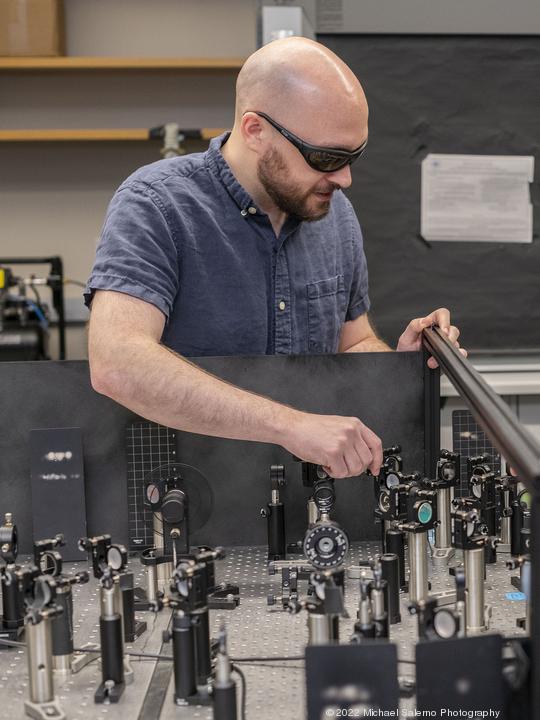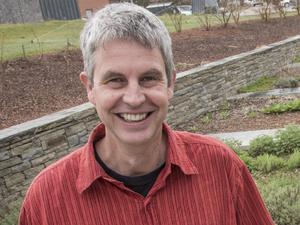
As a University of Rhode Island professor specializing in photochemistry, Dugan Hayes has spent a good part of the last few years studying and optimizing reactions that take place in the harvesting of solar energy and other clean-energy applications. Now, thanks to the discovery of a new chemical reaction by one of his students, Dugan has opened the door of possibility in releasing hydrogen for fuel cells.
For their discovery, Dugan recently won an Early Career Award from the U.S. Department of Energy to study the surprising reaction.
Hayes is one of 83 scientists nationwide chosen in this year’s round of Early Career Awards, which provide around $150,000 in research funding per year for five years. According to Dugan, he and Carson Hasselbrink, a Ph.D. student in the chemistry department at URI who will be graduating in the fall, stumbled upon something by accident.
"Carson was hoping to study a different reaction altogether using a technique called 'transient absorption spectroscopy' that uses ultrafast laser pulses to watch chemical reactions as they occur," Dugan said.
Want more innovation news? Sign up for The Beat, Rhode Island Inno’s free weekly innovation newsletter. See past examples here
Hasselbrink was trying to take a reaction and apply it to a slightly different molecule that absorbs visible light in hopes of measuring how much light it absorbs. "However, he found that after the expected product formed, it proceeded to undergo a subsequent photochemical reaction that released hydrogen. This was a huge surprise."
When the pair performed the modified reaction using a light-absorbing dye molecule called anthracene, they found that it produced reaction products no one had noticed before. In addition to the expected products, a subsequent reaction occurred creating compounds known as aldehydes — a process that involves the release of hydrogen gas.
"There's two basic parts of the molecule — one that absorbs light, and one that stores two hydrogen atoms," Dugan explains "After the molecule absorbs light, it spends a very short amount of time in what is called an electronic excited state, and while it is in this state, the two hydrogen atoms in the other part of the molecule break off and join together to form a single molecule of hydrogen gas (H2)."
Hayes said it's exciting from the standpoint of hydrogen fuel cells because it means that this molecule can store hydrogen in solid form at room temperature and atmospheric pressure and then release it for use in fuel cells just by shining light on it. The storage of hydrogen, Hayes said, is one of the big challenges facing hydrogen fuel cells, which could be used to power cars and trucks.
"The great thing about this material is that it can be regenerated by combining it with hydrogen gas using a catalyst and thus reused over and over," Hayes said. "The important thing about our discovery is that it happens in a molecule that is perfectly stable as a solid powder sitting in a jar for indefinitely long periods of time. Hydrogen gas as a fuel is great because it is entirely carbon-free and very energy dense by weight, but it stores extremely little energy by volume."
It can be liquified to solve this problem, but liquid hydrogen must be stored cryogenically at only 20 degrees above absolute zero. This technology allows hydrogen to be stored under ambient conditions and then released on demand using only light, Hayes said.
Producing large amounts of this material is simple, as it is a byproduct of coal processing and thus very cheap and abundant, Dugan points out. Moving forward, he said, the main challenge to using it in practical applications is working out how to expose enough material to sunlight at once to generate sufficiently large quantities of hydrogen.
"We're scientists first and foremost, so while we are excited about the idea of developing the technology for practical applications, engineers would be much better suited to that task," he said. "Our plan is to dig deep into the fundamental physics and chemistry of the reaction itself to understand how and why it works. Insights from this work will then allow us to design rational strategies for optimizing efficiency, increasing storage capacity, and improving reusability."
Sign up for Providence Business First’s free daily newsletter here








